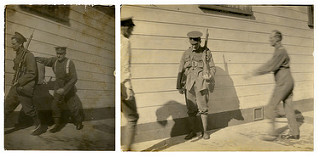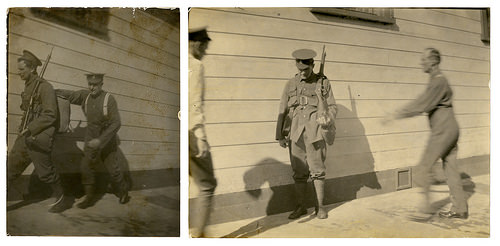Thomas Moynihan, conscientious objector, Wanganui Detention Barracks 1918
On 21 September 1918, Magistrate J.G.Hewitt released the report of his Magisterial Inquiry into the treatment of conscientious objectors imprisoned at Wanganui Detention Barracks. Believing strict discipline would 'reform' those who objected to military service on socialist or religious grounds, the detention barracks were set up in March 1918. Less than two months later, however, NZ Truth published allegations of mistreatment by guards and the camp's commandant, Lieutenant J.L.Crampton.
As the authority on conscription, Paul Baker, notes, "Prisoners who would not wear the uniform were forcibly dressed… [and] pushed, pulled, kicked, and punched around what Crampton called the 'slaughter yard.' Some were pulled with a rope round the neck, and repeatedly pushed into walls until their faces resembled 'raw steak'.
Concerned about the allegations, Defence Minister James Allen launched a Magisterial inquiry in June. The inquiry collected large amounts of statements from objectors and guards and found the allegations in the main to be true. "Although it was too carefully administered to leave much evidence" notes Baker, "Hewitt concluded that 'severe punishment' had been used." Yet due the hysteria of the day, in some quarters Crampton's actions were celebrated. The Egmont County Council congratulated him on methods 'no Britisher would object to." Encouraged, Crampton demanded a military court martial, and with the RSA as his council, he was found not guilty of 11 charges of ill-treatment.
Archives New Zealand holds the evidence collected by the Magisterial Inquiry, including full statements, drawings of the location of blood stains, and remarkably, these two photographs of Wanganui inmate and Irish-born objector, Thomas Moynihan, undergoing punishment. Moynihan had refused to drill, so according to his statement, he was stripped, beaten, forcibly put in uniform, and taken to the 'slaughter yard'. A rifle was then tied to his wrist, but as Moynihan refused to hold it, the gun kept slipping down. Guards allegedly smashed it several times against the side of his face "till the blood was streaming down." It was finally attached to his shoulder, and he was pushed, punched and forced around the yard for close to an hour, only stopping to have these photographs taken. In them you can see the string around his wrist, the wall inmates were allegedly pushed into, and shading on the concrete pavement that could possibly be blood.
After sustaining such abuse Moynihan was eventually coerced into taking a non-combatant role, and was transferred to the Medical Corps at Awanui.
Title: Territorial Force - Defaulters undergoing detention and imprisonmen
Archives Reference: AAYS 8638 AD1 Box Box 738/ 10/566 Part 2
archway.archives.govt.nz/ViewFullItem.do?code=22429857
One account of the court martial of Crampton can be found at nzetc.victoria.ac.nz/tm/scholarly/tei-WH1Arma-t1-body-d27...
For more information use our “ask an archivist” link on our website: www.archives.govt.nz
For updates on our On This Day series and news from Archives New Zealand, follow us on Twitter www.twitter.com/ArchivesNZ
Material from Archives New Zealand Te Rua Mahara o te Kāwanatanga

